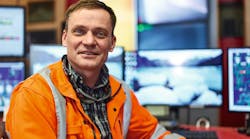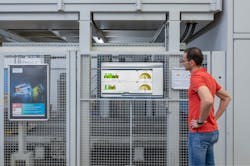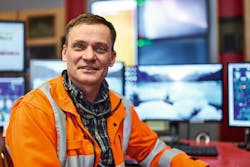Making Production Sustainable with Digital Tools
For decades, commodification and globalization have driven manufacturing businesses toward greater efficiency and cost savings. But the environmental impact of these process decisions is growing in importance. In the pursuit of reduced carbon emissions worldwide, companies are seeking advancements to address the requirement of sustainability.
Even with decades of investment into lean and efficient manufacturing processes, global production still consumes vast energy resources (54% globally) while producing a fifth of global carbon emissions. Getting to net zero by 2050 will be a challenge, and that is only one facet of sustainability. Companies are also looking at improved resource efficiency, energy consumption and circularity. And businesses need to be making these changes while meeting the traditional drivers of time, quality and cost for their products.
The traditional manufacturing approach is not well-equipped to address the number of variables on the path to sustainable production. Instead, a digital twin methodology that includes sustainability along with other operational parameters provides the detailed insights into the production process needed. To be successful, this approach should incorporate the collective intelligence across the entire value chain of a product and its lifecycle. Solutions must grow beyond plant-level optimizations, linking and analyzing data across the entire industrial operations—including supplier and partner ecosystems.
Tackling all of that at once is not feasible for every manufacturer, let alone entire industries, so it is important to understand some of the general concepts to implement in stages along the journey to sustainable production processes.
READ MORE: Bringing Sustainability from the Boardroom to Ground Level
From firsthand experience as a manufacturer and as a trusted partner to customers around the world in nearly every industry, there are four key areas where industries need to focus while shifting to sustainable manufacturing:
- Energy use
- Flexible production and innovation
- Service engineering
- Production line planning and optimization
Each provides benefits to creating a profitable and sustainable manufacturing business, but with collective intelligence they can enable your business to become an industry leader.
Planning and Optimizing Production Systems
Making changes to an operational manufacturing line is a costly endeavor when every second spent idle has an associated opportunity cost. That is why the digital twin of the manufacturing environment is such a valuable tool. Using this virtual representation of the factory or line, engineers can explore a wide variety of optimization operations without interfering with production until the optimal solution is determined.
Moreover, a digital twin can also help to continuously improve existing systems by incorporating real data collected through Industrial Internet of Things (IIoT) sensors, and using that to predict the physical system’s performance in the digital world and determine ongoing improvements. Analysis of this data provides a virtual representation of the processes and machines to better characterize and contextualize energy and production data.
This type of information constitutes the collective intelligence of lines, factories and enterprises; supplying your digital twin with this intelligence enables continuous optimization. The power is in its flexibility to be applied to nearly any sustainability goal within a manufacturing environment—energy efficiency, resource efficiency, machine longevity, repair scheduling, commissioning new equipment, etc.—for better sustainability outcomes.
Our customer, Hanson Cement, was able to digitally optimize and upgrade their low voltage cooling systems as it approached end-of-life with far more energy efficient motors. In addition to the inherent efficiency gains of the newer motors in the cooling system, they deployed variable speed control to match the cooling needs and minimize the input power of the system more precisely. The change worked so well that it paid for itself after just a few months due to the energy savings—roughly £86,000 ($110,554) in annual savings on electricity.
Improving Energy Efficiency
Energy consumption is already an important metric for most manufacturing businesses as a major operational cost. Reducing consumption per manufactured product also has an obvious sustainability benefit. Whether a factory is using electricity from the grid or on-site fuel to power their processes, there is an associated carbon footprint. They may also be under pressure to track, optimize and report energy consumption to follow the ISO 50001 standards.
Improving energy efficiency can have almost instantaneous benefits by reducing the total cost and carbon output. Since many businesses are already familiar with managing engineering requirements, it is the “low-hanging fruit” to implement these processes for sustainability changes.
READ MORE: BionicCellFactory Takes a Step Closer to Circular Economy & Higher Sustainability
The rush for energy efficiency has been most notable in Europe with the spike in energy costs. In response, some are deploying intelligent drive systems as part of a digital systems approach to cut energy requirements by up to 60%. Others are investing further with enterprise-wide energy management solutions to pinpoint the sources of greatest consumption and address them in descending order. Even more are deploying production monitors to help automate load management by switching off or idling equipment while not in use.
For example, one of our major customers in the food and beverage industry has cut energy use in a single facility by 13% and saved €110,000 ($122,482) in the first year through plant efficiency improvements. We helped them implement an end-to-end digital solution that connects their machines and factory sensors to the edge and cloud systems for operation. In addition to the energy savings, they can also better perform predictive maintenance to nearly eliminate emergency downtime.
Establishing Flexible Production
Flexibility and efficiency go hand in hand. Being able to quickly pivot and adapt to new market conditions with existing manufacturing assets can greatly reduce waste. Reusing existing machines and equipment is greatly beneficial in reaching sustainability goals. That flexibility might come from innovative manufacturing processes such as additive manufacturing, but it may also have a macro solution as is seen with modular production. Both of these solutions for flexible production allow facilities to be more easily retooled or reconfigured to manufacture any product on any manufacturing floor around the world.
YOU MAWO are a great example in deploying the flexibility of additive manufacturing and gaining sustainability benefits. Using a complete digital twin methodology of manufacturing, postprocessing, material handling and logistics, they are able to deliver custom eyeglasses to their customers. They 3D print frames to best fit the faces of customers as well as minimize material needed for structural rigidity. These choices created a 58% lower carbon footprint compared to conventional eyewear frames because of the material savings, as well as an improved time-to-market and future production scalability.
Promoting Service Engineering
Improving the longevity of equipment is yet another important focus area for creating sustainable production environments. Here again, this is not a new concept to manufacturers. Replacing machines is an expensive proposition, but so is conducting repairs at the last minute. By digitalizing these systems, maintenance cycles can be made more efficient in terms of time and resources. An Industrial IoT system connected to the digital twin of the manufacturing line can let operators know when a machine has dropped below a certain efficiency threshold and is impacting energy use, production capacity, worker safety or any number of important metrics to operation.
READ MORE: How Sustainability Permeates the Work of an Engineer
The connection to the digital twin enables prediction on the impact of these changes and maintenance can become a deliberate process rather than a reactive operation. A business might repair or replace a fault-prone component during expected downtime events or adjust processes to minimize the component’s chance of failure. Seeing these machines as long-term platforms provides businesses with another path to sustainable manufacturing. Instead of viewing these machines as disposable assets, keeping them operational provides more investment opportunities in the other concepts of sustainable manufacturing.
Real-World Example: Deployable Sustainable Production Solutions
While many digital tools available for improving manufacturing sustainability are still in the early stages of adoption, Siemens has brought them all together in a single digital-native factory in Nanjing, China. The Siemens Numerical Control (SNC) facility produces high-quality computer numerical control systems, drives and motors, and became a digital enterprise when it consolidated three production sites into one sustainable factory.
Using the approaches outlined above, they achieved some remarkable results:
- Doubled production capacity
- Increased efficiency by 20%
- Enhanced flexibility by 30%
- Reduced time-to-market by 20%
- Boosted space utilization by 40%
- Enhanced material flow efficiency by 50%
Equally important, the SNC facility further reduced plant-wide emissions with ground-source heat pump systems and photovoltaic arrays while decommissioning the most energy intensive machines on the floor in favor of newer models.
Making a manufacturing business sustainable is becoming a license to operate. The follow-through is the next important step to realizing the potential. It is important to understand that sustainability is not a bolt-on solution to existing processes. It needs to be present in every decision made throughout the product lifecycle and ecosystem. Fortunately, many of the best paths to sustainability already exist as profit incentives in today’s manufacturing businesses ,and we will continue to help develop the digital tools to make it happen.
Eryn Devola is vice president of Sustainability for Siemens Digital Industries, where she leads the Sustainability horizontal market. Devola completed an NFS Fellowship focused on Environmentally Conscious Manufacturing and has applied the knowledge she gained there to many roles in her career. Devola has a bachelor’s and master’s in mechanical engineering from Michigan Technology University, and an MBA from the University of Louisville. Click here to learn more about Siemens sustainability.




